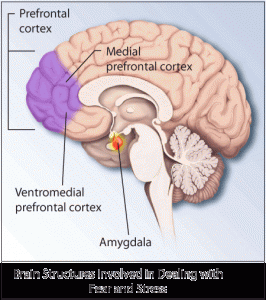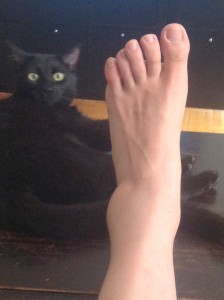Adrenaline and injury are an amazing pair of bedfellows. Twisting and spraining one’s ankle is a traumatic event.
When such an event happens the body releases adrenaline to stimulate the body in order to process and pass through the trauma that was just experienced. This is your “fight or flight” response.
“When a severe injury happens, the body’s adrenal glands secrete epinephrine, a hormone, that then increases blood pressure and heart rate, which helps the person suffering the injury run away or stay alive,” said Richard O’Brien, an emergency doctor at Pennsylvania’s Moses Taylor Hospital, and a spokesman for the American College of Emergency Physicians.
“It also gives you a runner’s high kind of feeling, which is why I’ve seen people who don’t notice the pain or injury until they calm down,” he said.
Day two of dealing with my sprained ankle wasn’t all that bad.
Not in too much pain (except for when my wife squeezed my ankle to check on it), the swelling has begun to go down on one side while it actually swelled a bit on the other side which didn’t happen when the injury first occurred.
When I got up yesterday morning I was a bit hobbled but again, not too bad.
I was limping with a slight turnout. I didn’t want to use the ankle too much so I drove into the city and parked in a lot to minimize how much walking I would do. The plan was to sit at the front of the room and teach without moving.
Unfortunately, I am not exactly the sit at the front of the room type of teacher. Even though I don’t administer many assists I like to walk around a lot looking at bodies in poses.
Within minutes I was up and about cruising around the room.
While the walk from the parking lot to the studio was fairly awful and the walk back to the car was no great shakes, the hour and a half of class felt as if I never got hurt.
“There are these moments that have windows where that serious injury can be overcome,” said Dr. Stephen Hargarten, professor and chair of emergency medicine at the Medical College of Wisconsin. “The pain part of it is related to the body’s extraordinary ability to manage pain in the way of producing endorphins, which are our own bodies’ pain meds, and the adrenaline, which helps us fight to stay alive.”
“The adrenaline rush is a real thing,” added O’Brien. “The desire or drive to stay alive and stay conscious can indeed block pain perception.”
At one point in class, I mentioned my ankle and pointed out the swelling and someone noticed that I was walking around well. And in fact, I was.
Walking quickly with no limp and no pain—my mind was clearly absorbed in its task at hand—I can only give credit to adrenaline and the body’s amazing ability to multitask and accomplish what it needs to accomplish.
***



